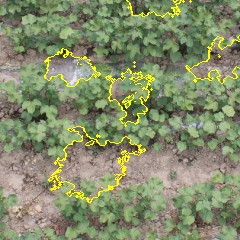import lime
from lime import lime_image
explainer = lime_image.LimeImageExplainer()
explanation = explainer.explain_instance(image, classifier_fn, labels=(1,),
hide_color=None,
top_labels=5, num_features=100000, num_samples=1000,
batch_size=10,
segmentation_fn=None,
distance_metric='cosine',
model_regressor=None,
random_seed=None)
参数说明:
image:待解释图像
classifier_fn:分类器
labels:可解析标签
hide_color:隐藏颜色
top_labels:预测概率最高的K个标签生成解释
num_features:说明中出现的最大功能数
num_samples:学习线性模型的邻域大小
batch_size:批处理大小
distance_metric:距离度量
model_regressor:模型回归器,默认为岭回归
segmentation_fn:分段,将图像分为多个大小
random_seed:随机整数,用作分割算法的随机种子
具体实现过程如下,我用lime查看我自己训练的efficientB1模型,具体代码如下:
"""
可解释模型算法
"""
import lime
from lime import lime_image
import numpy as np
from keras.preprocessing import image
import matplotlib.pyplot as plt
from skimage.segmentation import mark_boundaries
import PIL.Image as Image
from keras.applications.densenet import preprocess_input
from keras.models import load_model
from nets import efficientnet
def transform_img_fn(img_name,model):
out = []
img = image.load_img(img_name,target_size=(240,240))
x = image.img_to_array(img)
x = np.expand_dims(x,axis=0)
x = preprocess_input(x)
#out.append(x)
#return np.vstack(out)
return x
if __name__ == '__main__':
img_name = r"15_sr.png"
model_predict_01 = load_model("EfficientNetB1.model") #加载模型
images = transform_img_fn(img_name,model_predict_01)
explainer = lime_image.LimeImageExplainer()
x = images[0].astype(np.double)
explanation = explainer.explain_instance(x,model_predict_01.predict,top_labels=5,hide_color=0,num_samples=1000)
print(explanation)
#对图像分类结果进行解释
temp,mask = explanation.get_image_and_mask(explanation.top_labels[0],positive_only=True, negative_only=False,num_features=5,hide_rest=False)
img = io.imread(img_name)
img = transform.resize(img, (240,240))
image = img_as_float(img)
plt.imsave("out.jpg",mark_boundaries(image,mask))
解析的结果如下:























 3561
3561











 被折叠的 条评论
为什么被折叠?
被折叠的 条评论
为什么被折叠?








